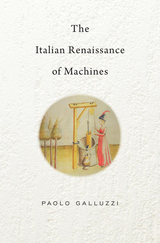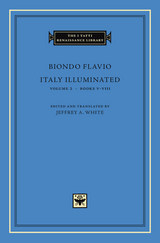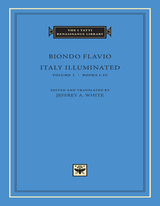417 start with I start with I


This study surveys the role of state enterprise in Italy over the last fifteen years. Focusing on the history and recent growth of the public sector there, the authors examine the structure, performance, and control of some typical state enterprises, the methods of finance, and the pattern of investment.
Their pioneering work, although it formulates no easy answers about the ideal role of public enterprise, marshals a great many useful facts and arguments concerning the one outstanding national experiment in this direction to date.

The Renaissance was not just a rebirth of the mind. It was also a new dawn for the machine.
When we celebrate the achievements of the Renaissance, we instinctively refer, above all, to its artistic and literary masterpieces. During the fifteenth and sixteenth centuries, however, the Italian peninsula was the stage of a no-less-impressive revival of technical knowledge and practice. In this rich and lavishly illustrated volume, Paolo Galluzzi guides readers through a singularly inventive period, capturing the fusion of artistry and engineering that spurred some of the Renaissance’s greatest technological breakthroughs.
Galluzzi traces the emergence of a new and important historical figure: the artist-engineer. In the medieval world, innovators remained anonymous. By the height of the fifteenth century, artist-engineers like Leonardo da Vinci were sought after by powerful patrons, generously remunerated, and exhibited in royal and noble courts. In an age that witnessed continuous wars, the robust expansion of trade and industry, and intense urbanization, these practitioners—with their multiple skills refined in the laboratory that was the Renaissance workshop—became catalysts for change. Renaissance masters were not only astoundingly creative but also championed a new concept of learning, characterized by observation, technical know-how, growing mathematical competence, and prowess at the draftsman’s table.
The Italian Renaissance of Machines enriches our appreciation for Taccola, Giovanni Fontana, and other masters of the quattrocento and reveals how da Vinci’s ambitious achievements paved the way for Galileo’s revolutionary mathematical science of mechanics.

In the later fifteenth century, the Kingdom of Hungary became the first land outside Italy to embrace the Renaissance, thanks to its king, Matthias Corvinus, and his humanist advisors, János Vitéz and Janus Pannonius. Matthias created one of the most famous libraries in the Western World, the Bibliotheca Corviniana, rivaled in importance only by the Vatican. The court became home to many Italian humanists, and through his friendship with Lorenzo the Magnificent, Matthias obtained the services of such great Florentine artists as Andrea del Verrocchio, Benedetto da Maiano, and Filippino Lippi. After Matthias’s death in 1490, interest in Renaissance art was continued by his widowed Neapolitan queen, Beatrice of Aragon, and by his successors Vladislav I and Louis II Jagiello.
The twenty-two essays collected in this volume provide a window onto recent research on the development of humanism and art in the Hungary of Matthias Corvinus and his successors. Richly illustrated with new photography, this book eloquently documents and explores the unique role played by the Hungarian court in the cultural history of Renaissance Europe.

From the earliest times, successive waves of foreign invaders have left their mark on Italy. Beginning with Germanic invasions that undermined the Roman Empire and culminating with the establishment of the modern nation, Girolamo Arnaldi explores the dynamic exchange between outsider and “native,” liberally illustrated with interpretations of the foreigners drawn from a range of sources. A despairing Saint Jerome wrote, of the Sack of Rome by the Visigoths in 410, “My sobs stop me from dictating these words. Behold, the city that conquered the world has been conquered in its turn.” Other Christian authors, however, concluded that the sinning Romans had drawn the wrath of God upon them.
Arnaldi traces the rise of Christianity, which in the transition from Roman to barbarian rule would provide a social bond that endured through centuries of foreign domination. Incursions cemented the separation between north and south: the Frankish conquerors held sway north of Rome, while the Normans settled in the south. In the ninth century, Sicily entered the orbit of the Muslim world when Arab and Berber forces invaded. During the Renaissance, flourishing cities were ravaged by foreign armies—first the French, who during the siege of Naples introduced an epidemic of syphilis, then the Spanish, whose control preserved the country’s religious unity during the Counter-Reformation but also ensured that Italy would lag behind during the Enlightenment.
Accessible and entertaining, this outside-in history of Italy is a telling reminder of the many interwoven strands that make up the fabric of modern Europe.

Biondo Flavio (1392–1463), humanist and historian, was a pioneering figure in the Renaissance discovery of antiquity; famously, he was the author who popularized the term “Middle Age” to describe the period between the fall of the Roman Empire and the revival of antiquity in his own time. While serving a number of Renaissance popes, he inaugurated an extraordinary program of research into the history, cultural life, and physical remains of the ancient world.
Italy Illuminated (1453), of which this is the second and final volume, is a topographical work describing Italy region by region. Its aim is to explore the Roman roots of modern Italy. As such, it is the quintessential work of Renaissance antiquarianism.



Movements—of people and groups, through travel, migration, exile, and diaspora—are central to understanding both local and global power relationships. But what of more literary moves: textual techniques such as distinct patterns of narrative flow, abrupt leaps between genres, and poetic figures that flatten geographical distance? This book examines what happens when both types of tropes—literal traversals and literary shifts—coexist.
Itineraries of Power examines prose narratives and poetry of the mid-Heian to medieval eras (900–1400) that conspicuously feature tropes of movement. Kawashima argues that the appearance of a character’s physical motion, alongside literary techniques identified with motion, is a textual signpost in a story, urging readers to focus on how the work conceptualizes relations of power and claims to authority. From the gendered intersection of register shifts in narrative and physical displacement in the Heian period, to a dizzying tale of travel retold multiple times in a single medieval text, the motion in these works gestures toward internal conflicts and alternatives to existing structures of power. The book concludes that texts crucially concerned with such tropes of movement suggest that power is always simultaneously manufactured and dismantled from within.

The Tria sunt, named for its opening words, was a widely used and highly ambitious book composed in England in the late fourteenth century during a revival of interest in the art of poetry and prose.
The backbone of this comprehensive guide to writing Latin texts is the wealth of illustrative and instructive sources compiled, including examples from classical authors such as Cicero and Horace as well as from medieval literature, and excerpts from other treatises of the same period by authors from Matthew of Vendôme through Gervase of Melkley. Topics treated at length include methods for beginning and ending a composition, techniques for expanding and abbreviating a text, varieties of figurative language, attributes of persons and actions, and the art of letter writing.
This anonymous treatise, related especially closely to work by Geoffrey of Vinsauf, served as a textbook for rhetorical composition at Oxford. Of all the major Latin arts of poetry and prose, it is the only one not previously edited or translated into English.

“The greenhouse effect is us, and it is specifically us in the Western world.” This is one of the messages at the beginning of Anita Gordon and David Suzuki’s startling view of our future on Earth. More than any other time in history, the 1990s have marked a turning point for human civilization. Not only are we facing ecological disasters that will affect our ability to survive, but the crisis is forcing us to reexamine the entire value system that has governed our lives for the past two thousand years.
Gordon and Suzuki warn us of the transition we will need to make if we are to arrive safely in the next century. More than a book on the environment, this is a book about us as a species: our shortsightedness, our failure to read the warnings, our inability to grasp the significance of our actions-and the tough decisions we have to make in order to save ourselves.
The power of the book lies in the consensus of the many voices, those of scientists and other scholars, that speak through it. The components of our predicament—global warming, soil erosion, acid rain, species depletion, ozone damage, rainforest destruction, overpopulation—are quantified with authority. And never before has such a strong consensus been expressed in a single warning. The message we receive is that our actions are taking place in a political and economic world that demands radical change.
In an effort to counteract this blueprint for disaster, Gordon and Suzuki present a resounding rebuttal of technological optimism and the belief that continued economic growth is a prerequisite for environmental reform. The intellectual fog of sustainable development is incisively dispelled, and in its place the authors suggest practical contributions that individuals as well as governments can make toward creating a “conserver society.”

Here is a complete biography of Ivan Aksakov, a prominent intellectual figure in Russia during the reigns of Tzars Alexander II and III. Aksakov began his fiery career as a critic of Slavophilism, a movement created by his brother Konstantin, along with Alexis Khomiakov, the brothers Kireevskii, and others, which sought to divorce Russia from the West and all Western influence. Circumstances, however, turned Aksakov into the fanatical leader of the Slavophiles, making him a passionate nationalist and Pan-Slavist, and a fierce anti-Semite. Although he accepted the reforms of the 1860's, he feared that their results would lead to the further Westernization of Russia; and, toward the end of his life, disillusioned and despairing, he lent a generous hand to reaction.
This book is based on a meticulous study of primary sources such as collected works, correspondence, private memoirs, and recollections.

During the sixteenth and seventeenth centuries, ivory diptych sundials were widely used to determine the time by day or night. These elaborate portable sundials, which could be adjusted for different latitudes, incorporated various devices useful for merchants and others who traveled extensively in Europe. This catalog illustrates in detail Harvard's collection of eighty-three ivory diptych sundials, one of the largest holdings of these instruments in the world. The collection encompasses a comprehensive array of styles and designs from Nuremberg, Paris, and Dieppe, the major centers of their production, as well as from other parts of Europe.
This catalog is the fourth publication of Harvard University's Collection of Historical Scientific Instruments, and the first to appear in twenty-two years. This collection, which was established in 1949 as a resource for the history of science and technology, has one of the three largest university holdings of its kind in the world. It comprises about 15,000 instruments covering a broad range of scientific disciplines dating from 1500 to the present. Illustrated catalogues of other parts of the collection are anticipated in the near future. These will include volumes on early telephones and phonographs, psychological instruments, and apparatus for teaching science in Colonial America.

In the split second that it took Associated Press photographer Joe Rosenthal to snap the shutter of his Speed Graphic, a powerful and enduring American symbol was born. Iwo Jima: Monuments, Memories, and the American Hero tells the story of that icon as it appeared over the next forty years in bond drive posters, stamps, Hollywood movies, political cartoons, and sculpture, most notably the colossal Marine Corps War Memorial outside Washington, D.C. The book is also a brilliant and moving study of the soldiers who fought one of our bloodiest battles and of the impact of Iwo Jima on the rest of their lives.
When the famous photograph first appeared in newspapers in 1945 it was little more than a grainy outline of massed men and their wafting flag, but for millions it captured the essence of American grit and determination. The Marines pictured were in fact in no immediate danger—they were replacing a small flag planted earlier atop Mt. Suribachi with a larger, more visible one—but to an enthusiastic public they were heroes risking their lives for Old Glory. The Battle of Iwo Jima raged for many days beyond the capture of this one position, and ultimately claimed the lives of almost seven thousand American servicemen, yet already the tableau symbolized victory and, as a politician said at the time, “the dauntless permanency of the American spirit.”
With passion and meticulous care Karal Ann Marling and John Wetenhall illuminate the ironies and misconceptions that proliferated around the two Iwo Jima flag raisings. Pride and nostalgia exalted the glorious epiphany of Rosenthal’s image and suppressed the grisly and at times mundane reality of war. The ordinary men whose action had been immortalized became uneasy celebrities, while the planters of the first flag were doomed to oblivion. From John Wayne’s epic Sands of Iwo Jima to the gargantuan bronze boots of the War Memorial to the parade-floats of Mt. Suribachi done in sweet peas and orchid-colored pompoms, overwrought patriotism blended with true valor.
The authors weave a fast-paced and vivid story from the reminiscences of survivors, rare archival sources, and dozens of documentary photographs. They give the first comprehensive account of the building of the Marine Corps War Memorial, dedicated in 1954. And in a riveting final chapter they follow a group of American veterans who returned to the island in 1985 and met Japanese survivors. Dedicated to the men who fought on Iwo Jima, this groundbreaking study in cultural iconography transcends the icon to show the honor in remembering what really happened.



READERS
Browse our collection.
PUBLISHERS
See BiblioVault's publisher services.
STUDENT SERVICES
Files for college accessibility offices.
UChicago Accessibility Resources
home | accessibility | search | about | contact us
BiblioVault ® 2001 - 2024
The University of Chicago Press









